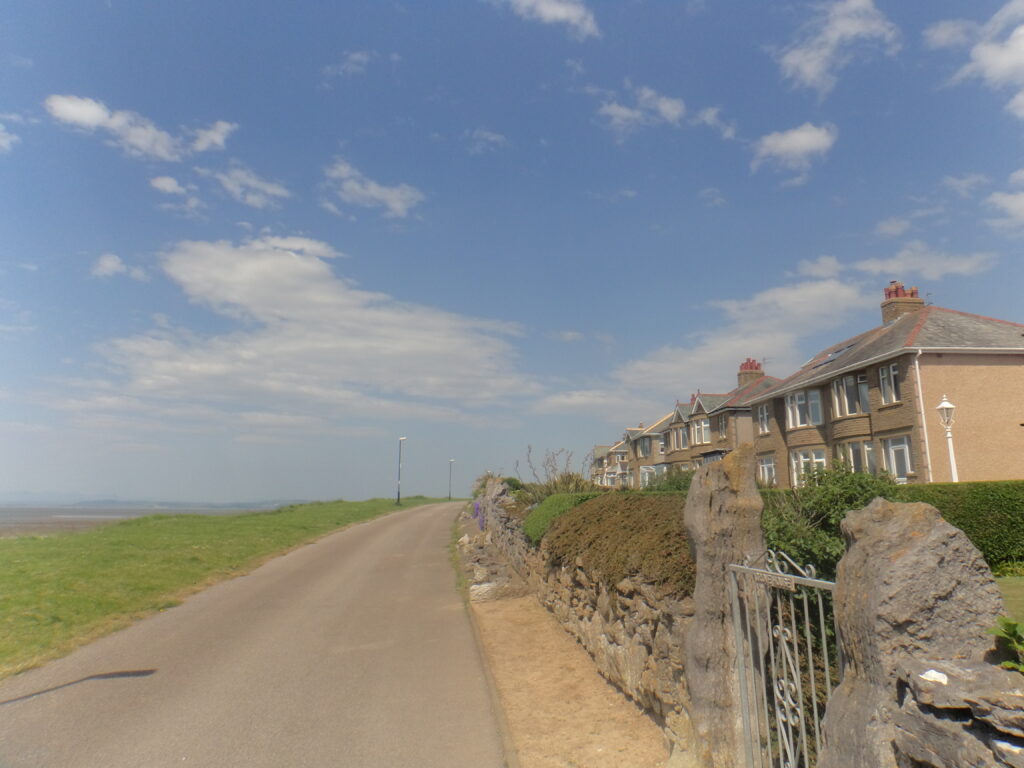
“And this house, and the sea, and the gulls, and memories: I have those you know . . .” Lucy Muir
Finally reading the book on which Hollywood classic, The Ghost and Mrs Muir[i] (1947) is based, it was pleasing to discover that my whimsical linking[ii] of the film to Morecambe and Heysham was quite justified in spirit, since the original novel, albeit set on the south coast rather than the Moriancabris Æsturis[iii] [Bay of Morecambe – fourth inlet north of Wales as classified by the Romans] has a much more suburban setting than the isolated clifftop mansion[iv] glorified by the black and white film.
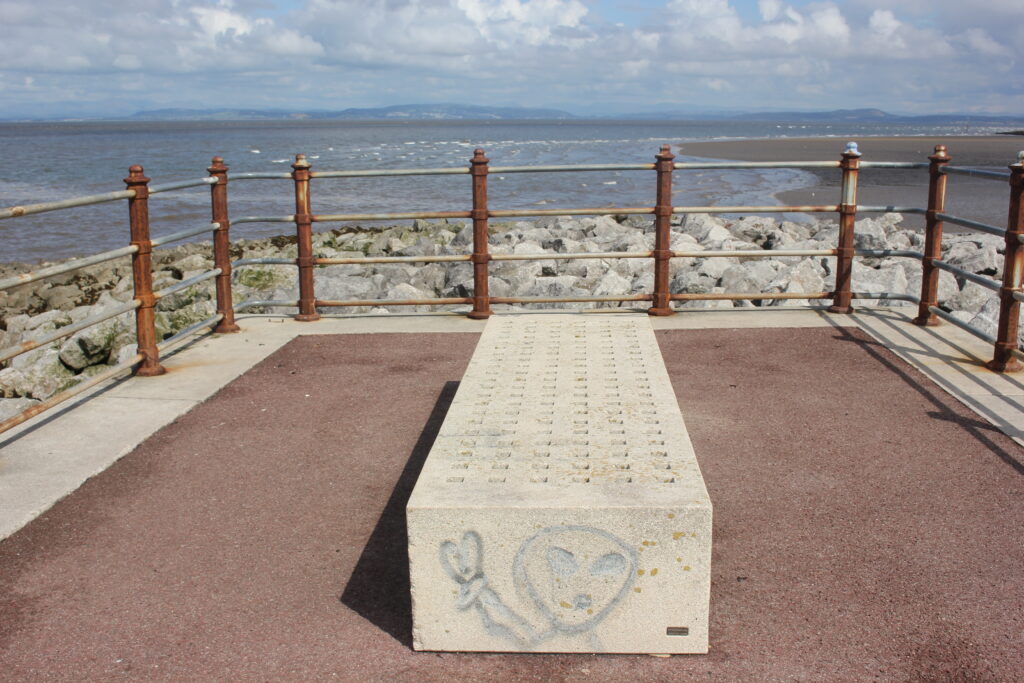
Ideal bench for an aggressive Munch[v], August 2021
Though enjoyable, the book is not in the same league. More sensible than semi-detached or swooning, it remains comparatively anchored to the earth. In the film, disconnected over time from everything, Lucy Muir – in love with a ghost who for me is as ‘real’ as anything else[vi] – passes a frontier infinitely less tangible than that between the beach and the waves, to leave her house behind, an airy tomb by the sounding sea . . .
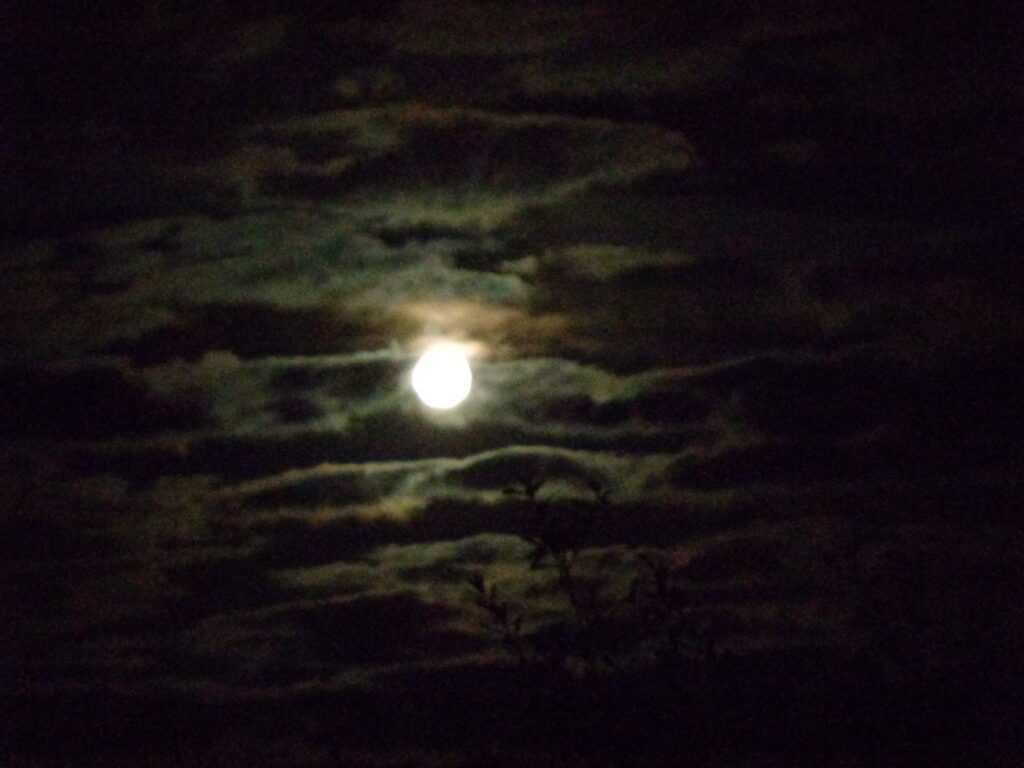
Though this resembles a nocturne by Albert Pinkham Ryder[vii], an artist latterly influenced
by Poe[viii], it’s actually a cheap camera’s sterling effort to capture a moon
over Morecambe Bay. Sept 1st, 2020.
Unlike Edgar Allan Poe, I once knew an Annabel Lee[ix] – though we were never in love, she never lived in the Morecambe area, and we weren’t exactly children any more. (I’m also fairly sure she had no “highborn kinsmen”, but I didn’t know her that well). In any case, she spelt her first name with two LLs and an E. So much then for my archly romantic title, at least on the surface . . . The subtitle[x] however, is frequently true enough around here, especially in fine weather.
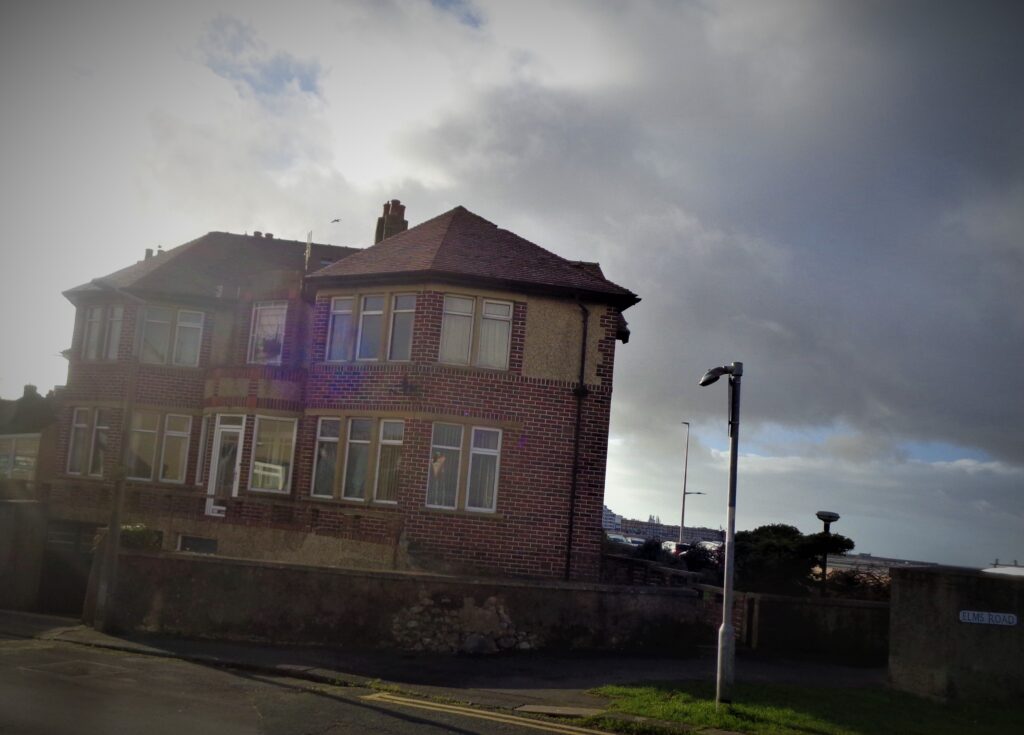
Tilted suburbia, Bare, Morecambe, January 2022
So is the shade of Lucy Muir the occasionally present queen of this undefined kingdom of mine? – As if the house she came to rent at the turn of the last century, once stood, quietly isolated above Heysham sands[xi]. Can the environs of Morecambe and Heysham even constitute a kingdom except in some arcane yet light-filled cavern at the back of my mind?
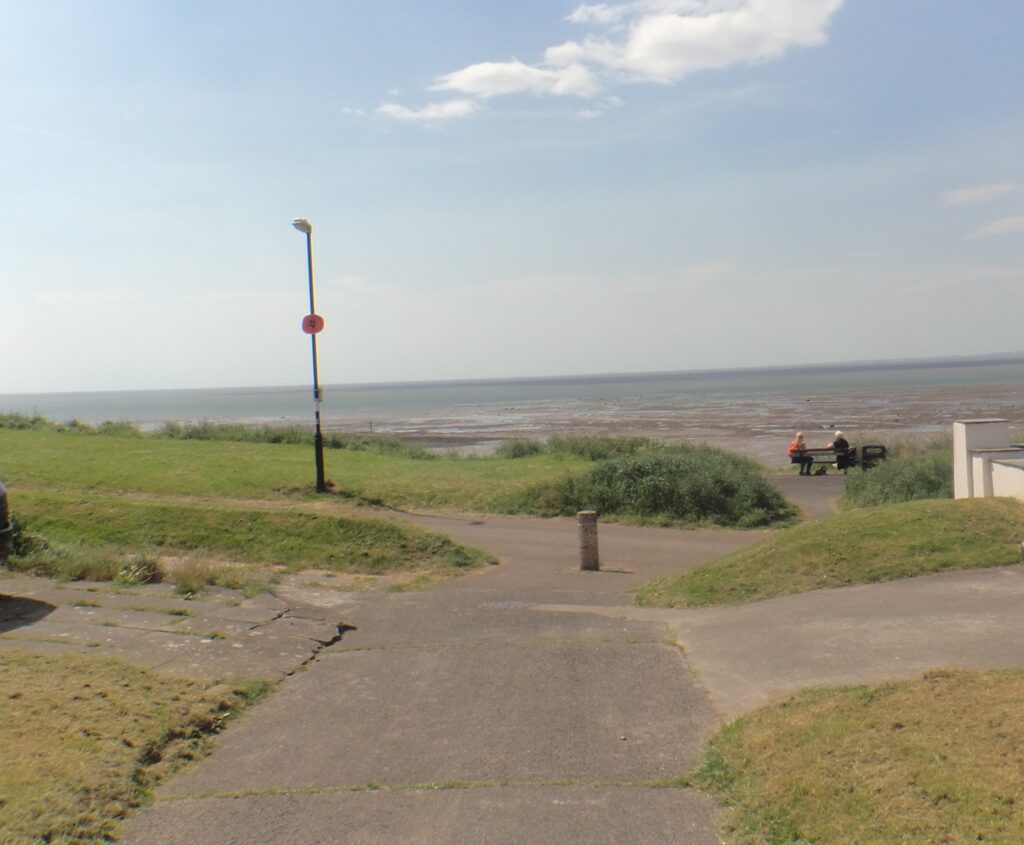
May 2018
In Heysham old village further down the coast, a lumpen, wall-mounted relief, depicts the Spirit of Heysham as a gormless Medusa being careless with the stars and some species of ball[xii]. I took an accurate photograph of this depressing sculpture in 2019 but have no wish to tarnish all my intangible feelings with the inevitable result. It’s certainly not her kingdom that my itinerant mind dwells upon. Break free! No deities or personages are necessary – not even Gene Tierney[xiii] as Lucy Muir. A more abstract genius loci is fine.
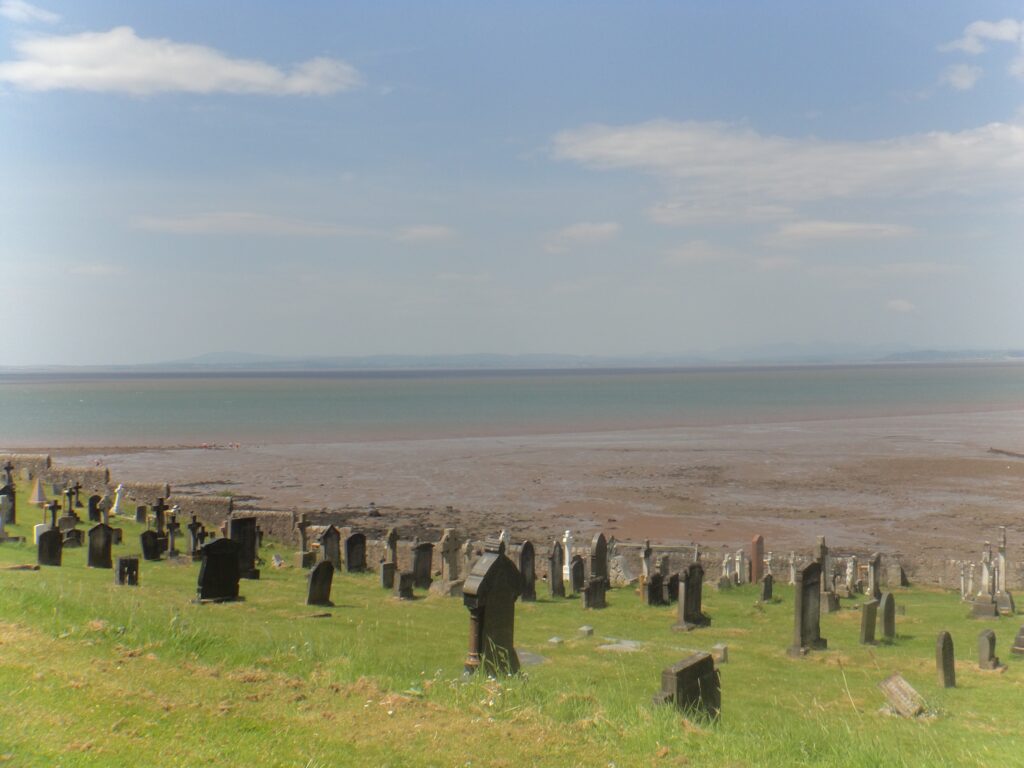
Moonfleet . . . sorry, Heysham Old Village graveyard. But where is Stewart Granger? May 2018
Chains of association are very personal. When I feel free, all my lived time easily fuses. It’s quite natural for me to sideslip from The Ghost and Mrs Muir through Poe’s Annabel Lee[xiv], into Roger Corman’s filmic adaptations of Poe[xv] with their frequent evocations of kingdoms either by the sea (The Pit and The Pendulum, 1961[xvi]) or so misty (all of them), that the fog becomes a sea itself, a sea in which the film floats . . . just as the dacha[xvii] at the end of Tarkovsky’s Solaris (1972)[xviii] is created – a new, possibly untrustworthy or regressive island in a swirling sea – by the empathetic inquisitions of the strange planet or entity.
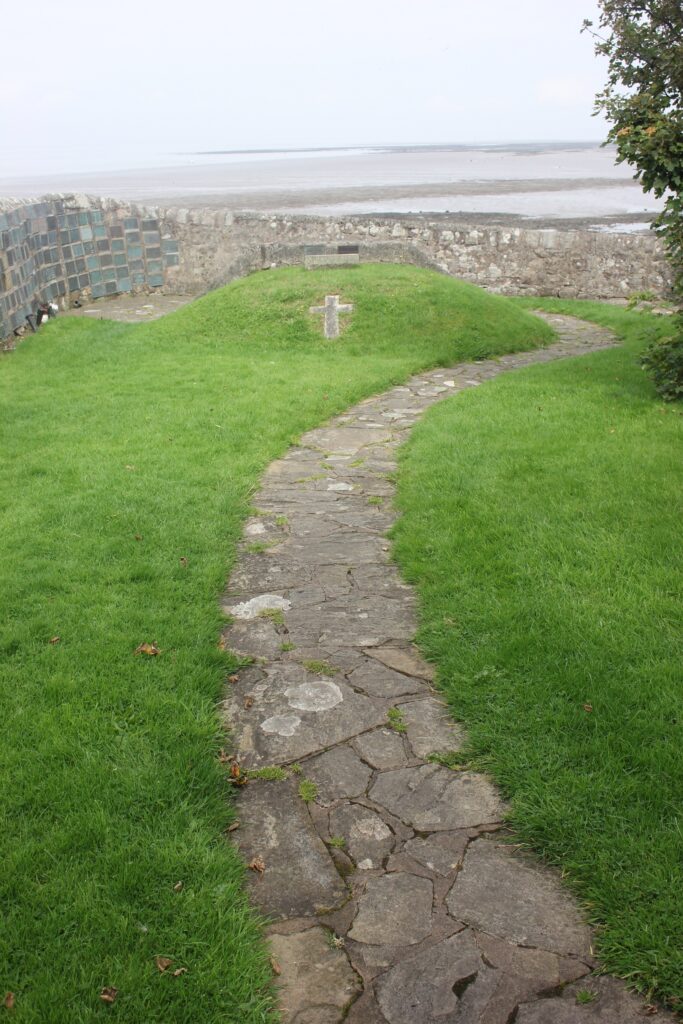 The questioning path? St. Peter’s Heysham, 26th August 2019
The questioning path? St. Peter’s Heysham, 26th August 2019
Despite forced perspective[xix] or the complications of the Schüfftan process[xx], despite the use of cardboard, paint or lashings of dry ice, all the most vivid filmic places (detached if necessary from stupid characters and plots) can be more real than reality – at least in memory. This can certainly be true of the atmosphere which permeates sections of 1970s maybe underrated film, The Dunwich Horror[xxi].

The Tan Fade Horror, 18th January 2022
The best version of films, books, paintings and so on, is frequently that impression left behind in your head – a separate thing which can both condense and expand over time, often leaving the source material a disappointment. Films especially, being relatively short yet generally narrative driven, often complete themselves in the watching. I’m convinced that all the truest art – in whatever medium – never does this and always remains open – its perfection concealed within its ‘imperfections’, its chords ringing inside us[xxii].
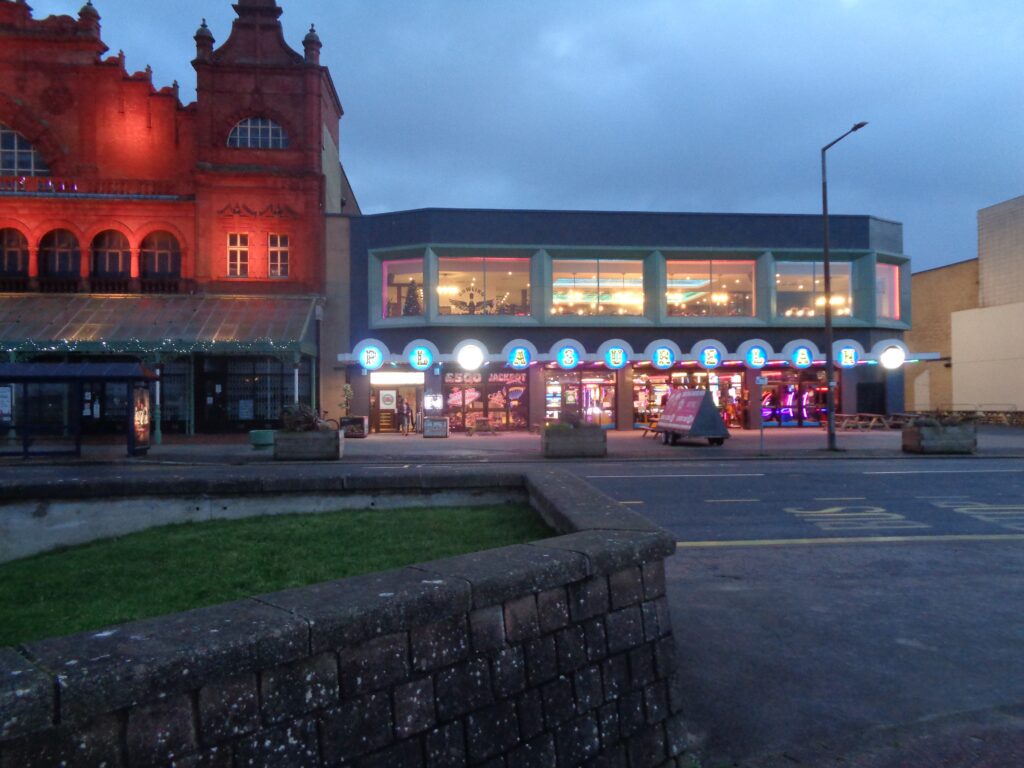
P L E A S U R E L A N D , New Year twilight, 3rd January 2022
The Dunwich Horror’s dream-haze landscapes share real Californian coasts with The Ghost & Mrs Muir, while distribution and production link it to earlier Poe adaptations. Here though we are in a world derived from Lovecraft – whose links with Morecambe, I would have imagined non-existent. Not so, for Morecambe and Heysham are the setting of a Cthulhu Mythos[xxiii] novel The Weird Shadow over Morecambe by Edmund Glasby (2014).
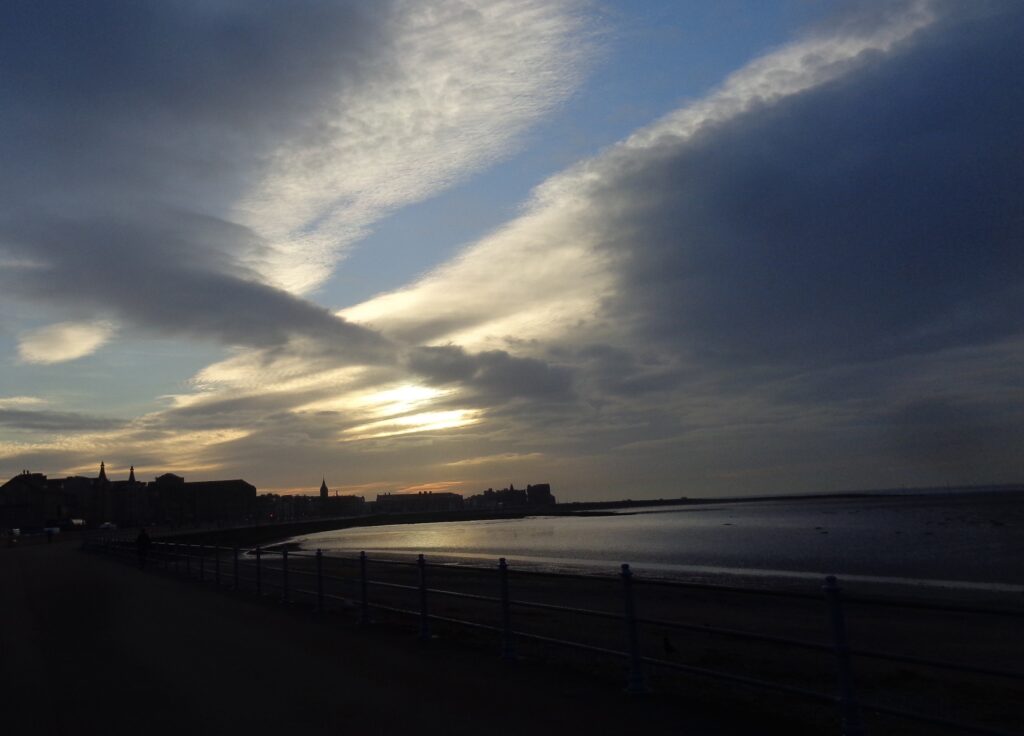
The shadow of night over Morecambe’s West End – reputedly the rougher part of town, 18th Jan 2022
Glasby’s title alludes To Lovecraft’s The Shadow over Innsmouth[xxiv]. Both seaside horrors are as yet unknown to me[xxv], but there’s no doubt that the sweep of Morecambe Bay gliding south from the relative isolation of Park Point and Far Arnside via Silverdale to Jenny Brown point[xxvi], skimming on to Hest Bank, Poulton-le-Sands[xxvii] and central Morecambe, finally to alight at Heysham’s old village (with its lingering similarities to the 18th Century world of J Meade Faulkner’s Moonfleet[xxviii] as well as its 1955 film adaptation by Fritz Lang[xxix] starring Stewart Granger) contains such a wealth of contrasts, that from pantheism to cosmic indifference[xxx], practical type thoughts need rarely enter the mind . . . unless you really can’t shut them out. The charging immediacy of the places is also apt to banish such housework.
According to a positive review, Edmund Glasby conjures an “increasingly bizarre version of reality” from some of Morecambe and Heysham’s most distinctive lineaments[xxxi] – presumably not including any references to the person or statue of that well-loved comedian of my childhood, Eric Morecambe?[xxxii]
![]()
 Happy Mount Park, May 2018
Happy Mount Park, May 2018
[Notes from 2018]:
After lunch at Happy Mount park (!) where the collective air was like something from a William Roberts fantasy . . . though neither so tubular nor robotic – a kind of ideal proletarian paradise . . . Shame most of these citizens probably vote conservative?

Happy Mount Park, August 2019
Anyway, after the park, K took the children to the beach while I boarded a 1957 double decker bus to Heysham Village. It’s hard to believe how beautiful this area was – I’d assumed that all the Heysham peninsula would be an industrial wasteland leading to the mess of the nuclear power stations, but Heysham old village coastal area and chapel was more like Dorset (in fact it reminded me of a walk K and I did from Weymouth to Wyke Regis via Sandsfoot along the beach in summer 1990). Meanwhile above Heysham Sands, streets of a slightly downmarket Metroland adjoin a curving bay with buttercup fields and an almost Moonfleet atmosphere – even in bright daylight.

Heysham houses down to the sea, May 2018
Short suburban roads lead to a prospect of the sea, the bay and across the water all the distant mountains of the Lakes . . . yet soon you’re back into the seedy ‘Kiss-me- Quick’ Morecambe of run-down hotels and dodgy looking markets – a scaled-down, gentler version of Blackpool perhaps?

‘Personal and planetary, political, societal, accusatory; against tact, against compromise, against the
inner deaths and personal prisons we tirelessly remake . . . all the nails of the human condition are
hammered home.’ [xxxiii] Morecambe arcade, 18th January 2022
To live off grid has always been one of my aims – which may be next to impossible with a family in a small, overpopulated country. For years we manged to live in areas where the landscape was too remote or bleak to be easily colonised by tourism, second homes or holiday lets. There are aspects of the grid acceptable to me – how else could anyone read what’s written here? But even without television, radio or a mobile phone, is it possible to maintain such a stance in the middle of a town?

West Street, Morecambe, looking towards the promenade and sea beyond the bushes
It’s not that I have anything against people. In fact, I’ve been lucky enough in the last couple of months – via a Morecambe writer’s group with multiple incarnations including a film night – to make an entirely new circle of friends. It’s more the inadvertency of society to which I object: that en masse it’s going in a direction few of us would ever want as individuals.
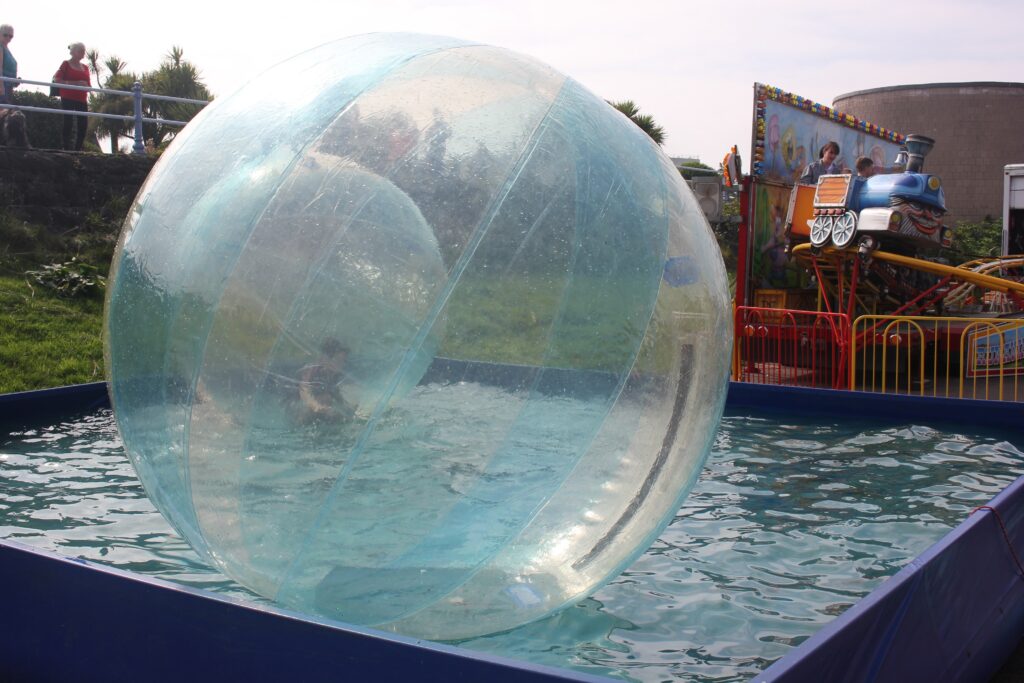
“I am not a number, I am a free man!”[xxxiv] August 2019
Yesterday my sister emailed me to quote from Glennon Doyle’s Untamed[xxxv], “Maybe my inability to adapt to the world is not because I’m crazy but because I’m paying attention. Maybe it’s not insane to reject the world as it is. Maybe the real insanity is surrendering to the world as it is.”
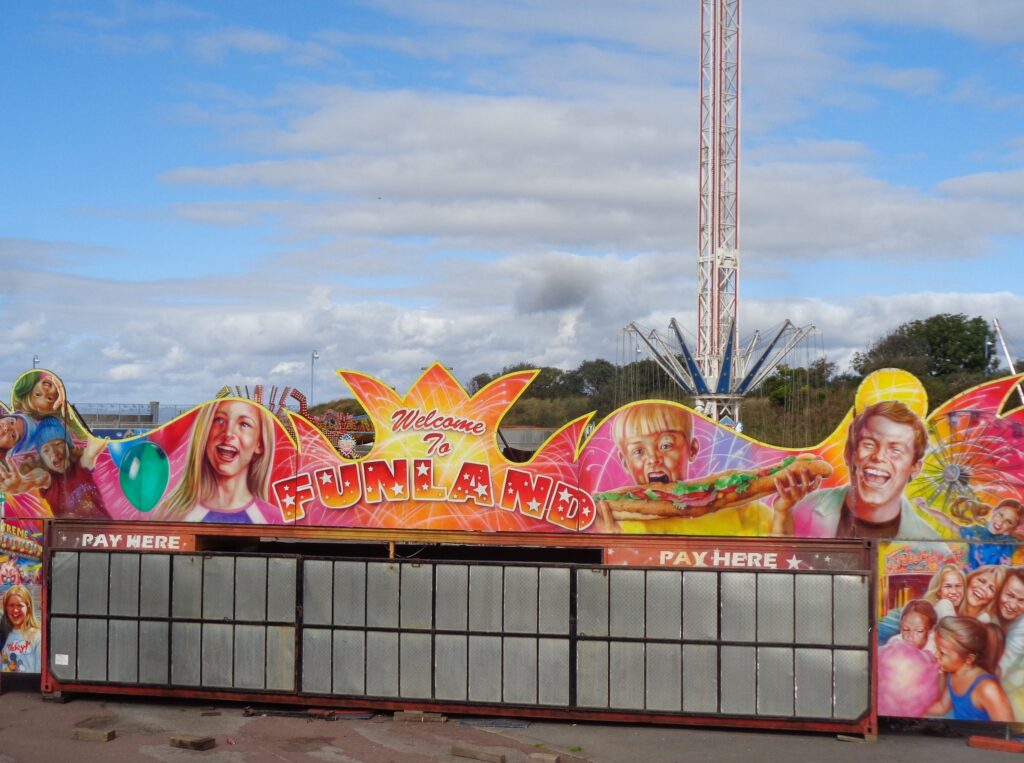
A temporary FUNLAND just east of the Midland Hotel – likely site of a new Eden project. Sept 2021
Even back in some imaginary, loose-form Heysham suburbia of the 1900s, was Lucy Muir frustrated by the human condition? Despite her spark and occasional engagement, she certainly appears to weary of human life very quickly. For someone who apart from a little scrubbing and water-bottle filling and a walk or two along the beach, (plus a few months transposing the words of a dead sailor – or seaman as the captain prefers, “sailor is a landlubber’s word”) the flour gathers more quickly in her hair than in that of her hard-working servant Martha.

The Brunswick Road Laundry, 3rd January 2022
Edna Best[xxxvi] who portrays Martha, was 20 years older than Gene Tierney but ends up looking younger. Is it Lucy Muir’s daily engagement with the metaphysical that makes her increasingly grouchy with Martha and tires her out? I’ve always hoped that the opposite would be the case. In human terms, Martha must be equally lonely, but being working-class her inner feelings are assumed to be of no interest[xxxvii]. When, not long after scolding Martha for “bossing” her, Lucy shuffles off with middle-class dignity – suffering no more than a funny pain in her arm and causing no more trouble than a glass of split milk for grief-stricken Martha to clean up – her ghostly version brushes past the servant with at least a passing sympathy. Despite that my own grandmother worked as a domestic at only a slightly later point in time, I don’t feel too bad about this. The implication being that all inequalities will be put right after death by eternity . . . which might be true yet can also function as a dangerously complacent notion pandering to the “All things bright and beautiful” scheme of class fate.

All things blanched and beautiful: The Midland Hotel[xxxviii] seen from a 40s double decker, May 2018
As almost everywhere, the railways of Morecambe were once far more extensive[xxxix], encompassing even a problematic harbour. Like Morecambe’s two piers, this has vanished apart from the stone jetty once forming its more southerly arm, now incorporated into coastal defences, with its old station building, now a café. Declining from a traffic peak in the 1950s, Promenade Station closed in February 1994, its tracks removed to terminate at buffers 300 metres further inland. At least the original building, opened by the Midland Railway in 1907, survives as a pub, restaurant and entertainment venue.
Pre-grouping[xl] railway companies were notoriously determined kingdom builders. The North Western Railway extending its tendrils from Leeds and Bradford[xli] made Morecambe (sometimes referred to as Bradford-by-the-Sea) a favoured resort for holidaymakers from the West Riding of Yorkshire, during Wakes week[xlii].
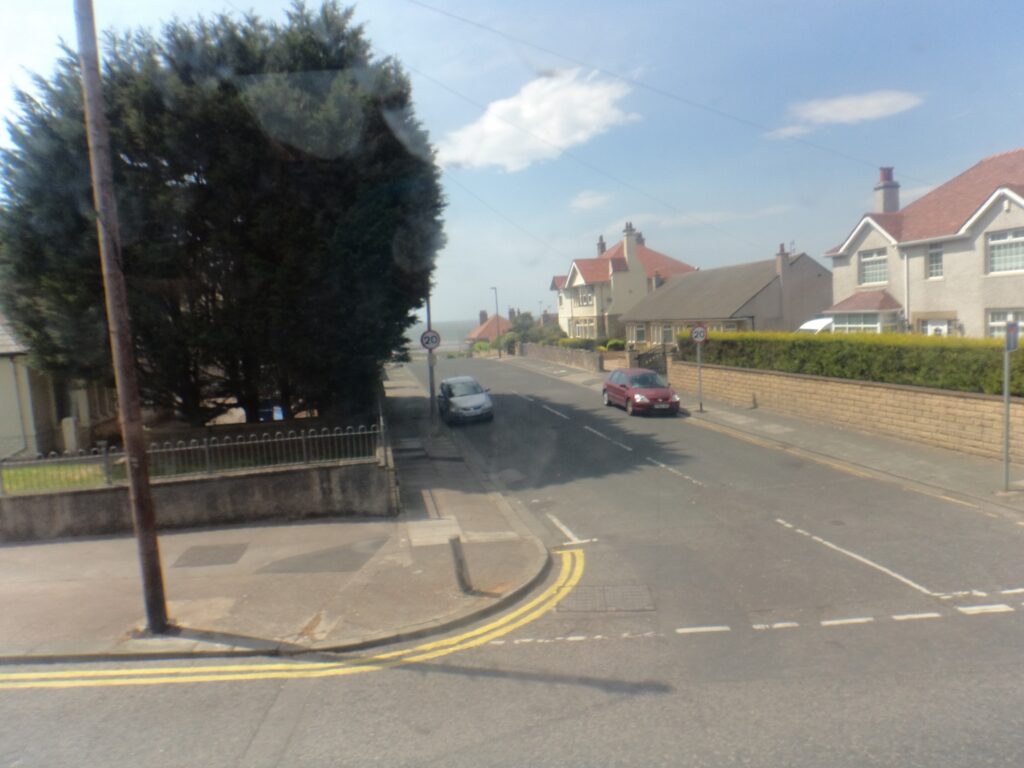
Heysham Avenue, May 2018
So where does my post-railway-empire, kingdom by the sea, careless of reality – begin and end? Not surprisingly, its frontiers shift. The positive feelings engendered by its seaside suburban heart are summoned especially by fine weather. In bright sunlight the kingdom expands across the water or sands and sediments revealed by the tide, north and south along the coast.

Park Point, Far Arnside, April 10th, 2021
Beautiful weather certainly held sway on my first rambling exploration of Morecambe and Heysham in May 2018[xliii] – an occasion that came about quite by chance, when posters in a bus stop near where we lived on the opposite side of the bay, advertised the Ribble Vehicle Preservation Trust’s[xliv] annual vintage bus day[xlv].
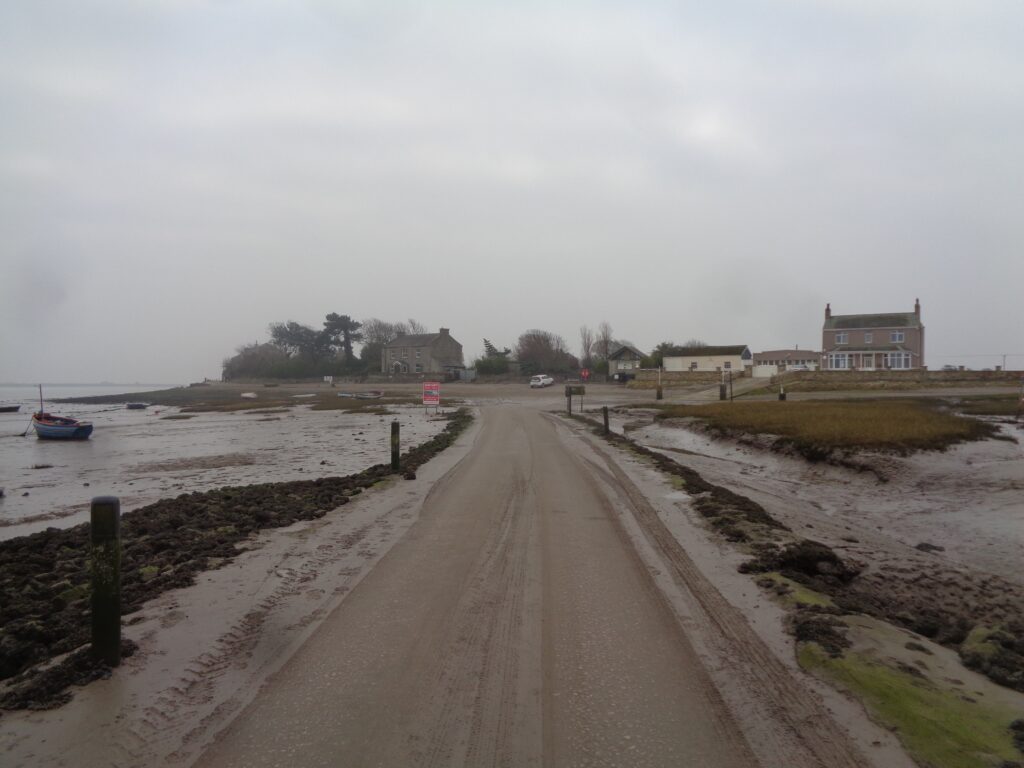
Sunderland village – tidal road on the way to Sunderland Point, 25th January 2022
Perhaps the kingdom extends south as far as Sunderland Point[xlvi] whose village out on a spit where the Lune loses itself in the sea, seems inclined to resist the drag of society. Until last month I’d never been that far. A good friend who lives there warned me that you need to know the tide times, for the road is cut by the rising sea twice a day. Apparently, Sunderland Old Hall[xlvii], on first sight, immediately reminded her of The Ghost and Mrs Muir.
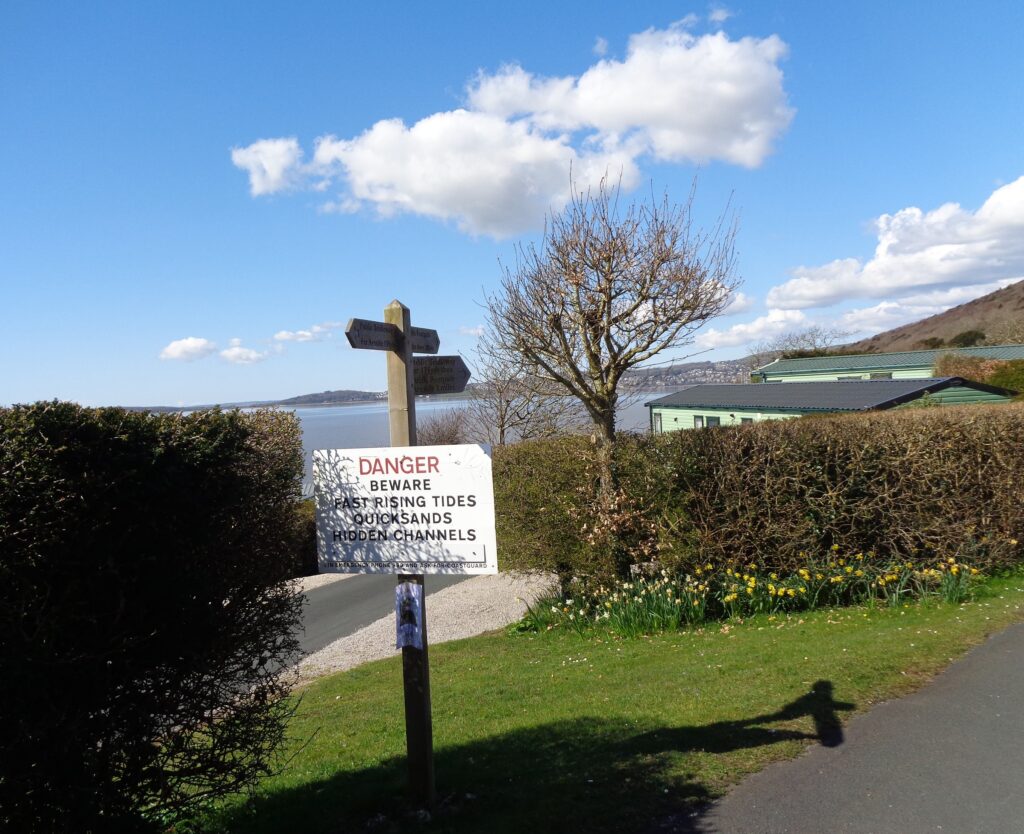
Far Arnside Holiday Park – one of many caravan paradises – April 10th, 2021
Far Arnside, 20 miles up the coast, with its upmarket static caravans and ‘lodges’ in the woods left behind, on a good day might feel the furthest northern point of the kingdom. Beyond the tarmac trails, slender woodlands slope to short white shingle beaches or fade to rocky maritime outcrops above the tides. Inland, winding paths rise to high knolls outlying, unencumbered, also crowned by gorse . . .![]()
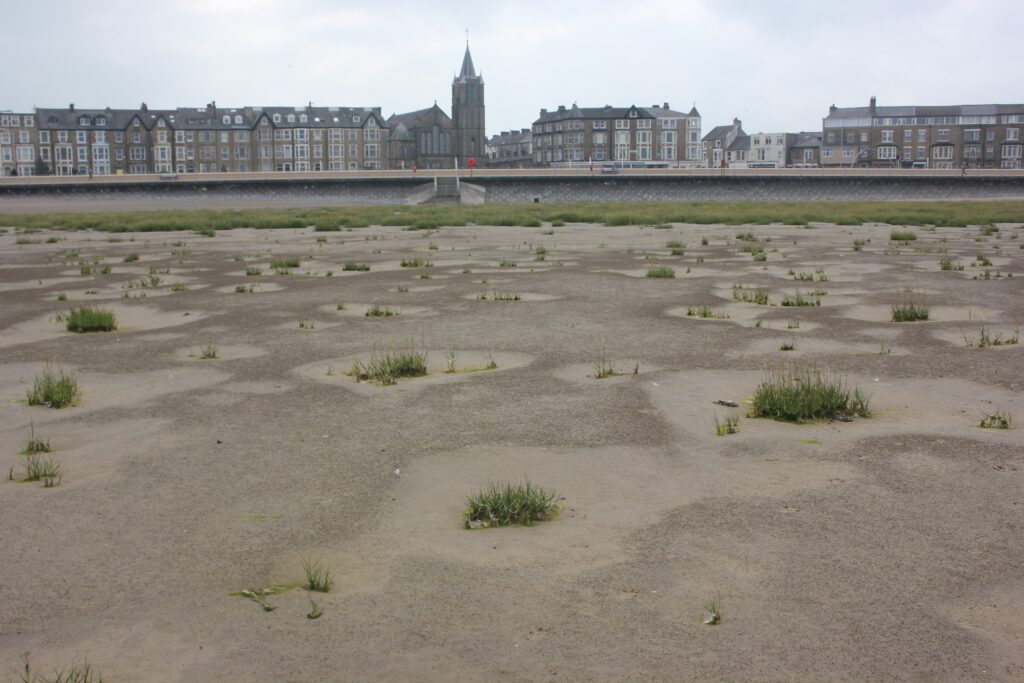 Moonscape: Sea of Tranquillity. August 2019
Moonscape: Sea of Tranquillity. August 2019
Once Morecambe’s West End Pier[xlviii] stood somewhere here and I like to think that it would have
had a mermaid attraction like that central to Curtis Harrington’s Night Tide of 1961[xlix]
Back in Morecambe, when the tide recedes, does the sense of interior space expand? Land for water is available if you keep an eye on the time. If you watch and listen carefully for the sea’s, at first insidious[l], return. Even if actual quicksands are rare, their location constantly shifts.
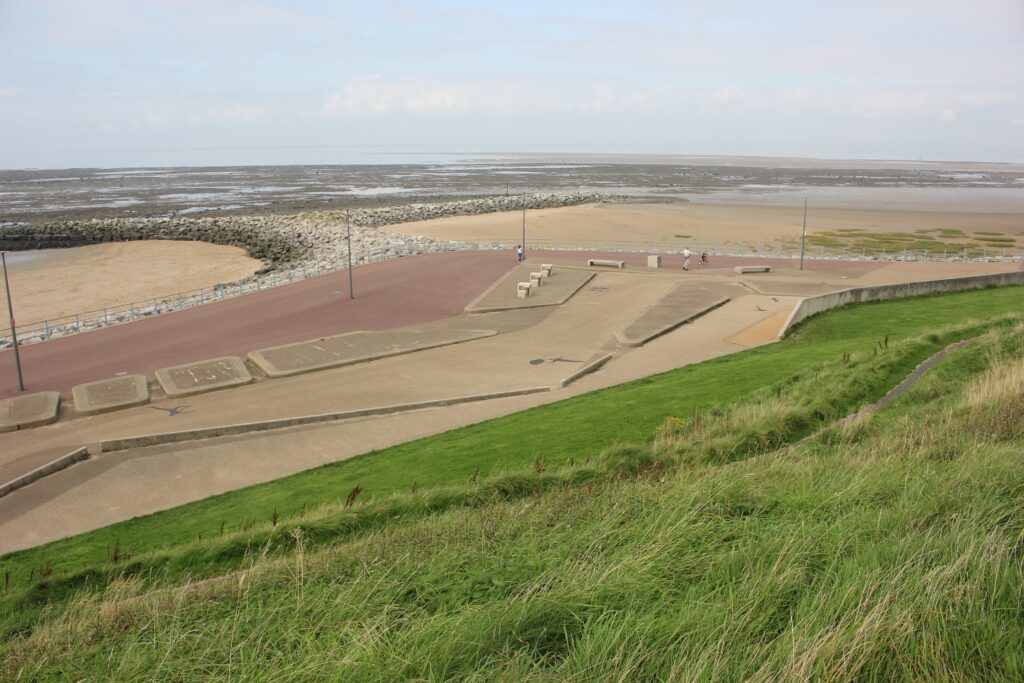
August 2019
Lucy Muir has no such fears. In her bay, the shingle and sand are fixed no matter how high the waves crash. The time condensing sequences – in the tradition of fluttering candles, flying clock hands, blown leaves – thanks to the universal emotion of Bernard Herrmann’s music[li], are concise and poignant. Lasting only 50 seconds, more than a decade passes. Later, to shift the film towards its close, another 20 years is over in 37 seconds.![]()
“How you’d have loved the North Cape and the fjords in the midnight sun, to sail across the reef at Barbados where the blue water turns to green, to the Falklands where a southerly gale rips the whole sea white! What we’ve missed Lucia! What we’ve both missed.”
So runs Rex Harrison’s farewell speech to a sleeping Lucy. Sensing he’s become an interloper in her life, regretfully the ghost captain has determined to fade away. His rousing soliloquy is a clear cinematic precursor to Rutger Hauer’s tears in rain monologue in Bladerunner[lii]
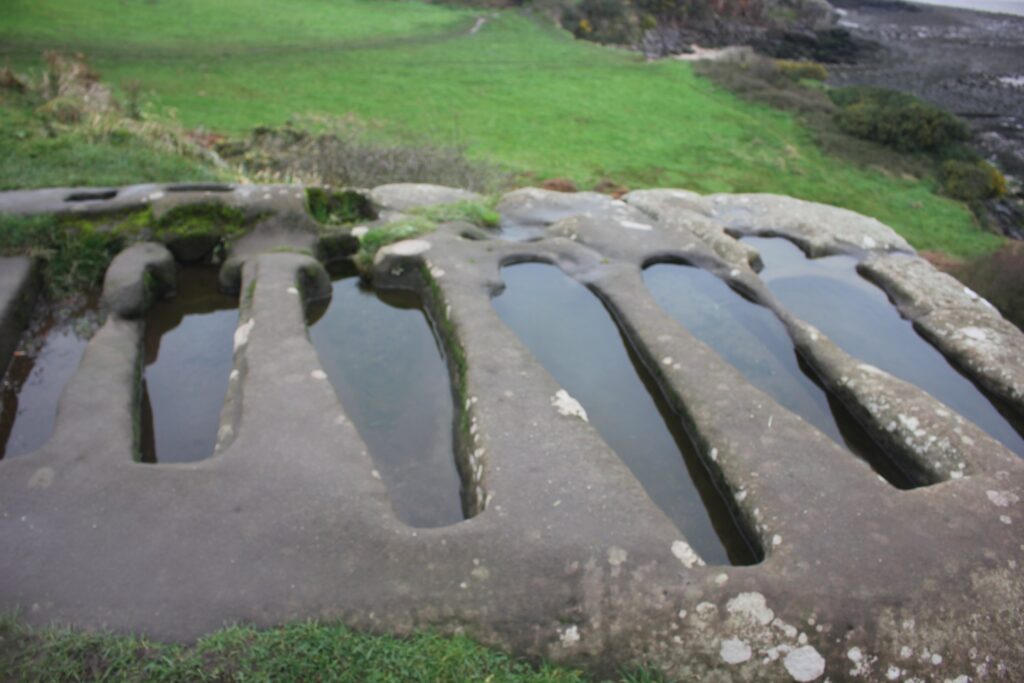
Ancient rock-cut graves at St. Patrick’s Chapel[liii], Heysham Head, 9th December 2020 –
the site features often in Glasby’s The Weird Shadow over Morecambe
Of at least five other films which are heavily or crucially dependant on the music of Bernard Herrmann: Citizen Kane (1941) Vertigo (1958), Psycho, (1960), Fahrenheit 451, (1966) and Taxi Driver (1976), The Ghost and Mrs Muir (1947), not surprisingly, is the most conventionally constructed – a calculated product of the studio system. Yet despite the surface of the formula, it’s a bittersweet tragedy with a triumphal mystical ending – as perhaps befits a film produced shortly after the Second World War.
 Hest Bank, looking south west, 9th Sept 2021
Hest Bank, looking south west, 9th Sept 2021
More concisely, the kingdom probably centres on the coast between Hest Bank just to the north of Morecambe and Heysham Head to the south. Beyond the headland lies the port for Irish freight and the Isle of Man. Dominated by the looming blocks of the two adjacent nuclear power stations, even sun-struck this zone is dystopian. The two generators are threatening punctuation marks, easily visible from as far away as the Furness Fells above Ulverston.

Heysham 2 (on the left) and 1 nuclear power stations. Disasters in the making . . . July 2020
Alternatively, closing in further still, the promenade which stretches from Happy Mount Park over 4 miles south to Heysham old village to the south, could be seen as the drawn bow defining where this kingdom meets the sea, that ‘tenuous fringe – path, railings, sea defences’ which ‘draws a submarine future between silent bedrooms and the elemental roar.’[liv]
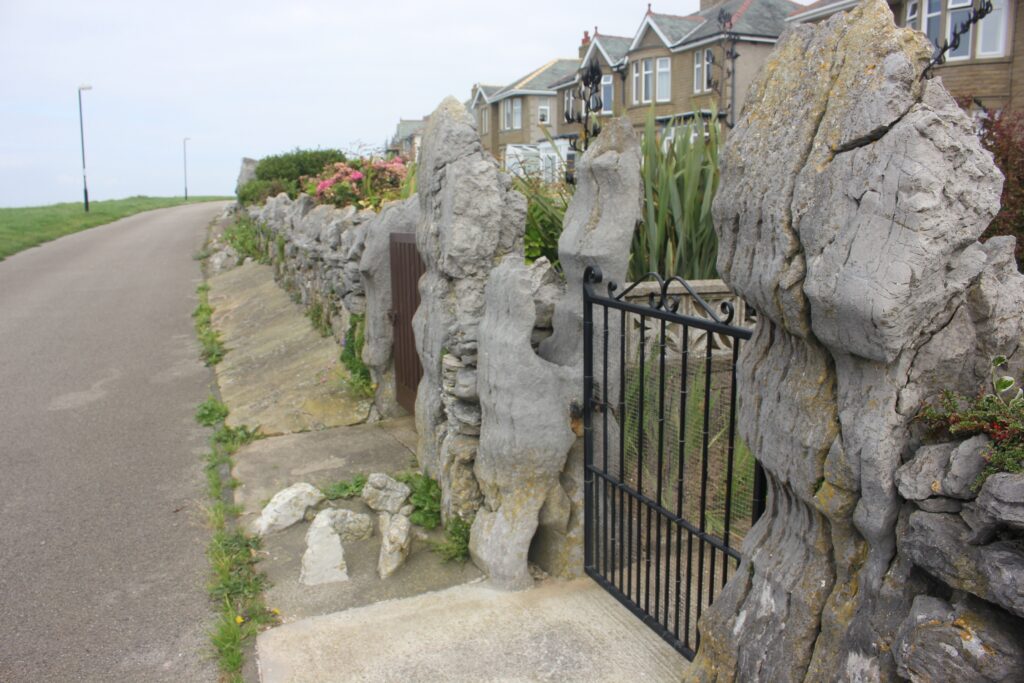
‘Their gardens wait – territories guarded by the characteristic stones beloved of walls around here:
whispering knights[lv], frozen warriors, melted chess pieces after the blast’ [lvi]. Aug 2019
Ideally, I would have liked to have finished this digression in a relaxed flaneur-shallow manner at the beginning of last year, when Morecambe and Heysham were places I could visit and leave, travel through on the swift surface of the tourist promenade, without getting sucked into the backstreets, the social and political reality.
Now, I live here.
Now, I’m nailed into the grid.
End of Part One.
© Lawrence Freiesleben,
Cumbria and Morecambe, May 2018 – February 2022
NOTES All notes accessed between Jan 19th and February 2022
[i] https://www.imdb.com/title/tt0039420/?ref_=nv_sr_srsg_0
[ii] https://internationaltimes.it/home-is-where-christmas-is/
[iii] https://en.wikipedia.org/wiki/Morecambe
[iv] Sadly, the house was only a façade, dismantled after filming: https://hookedonhouses.net/2011/09/12/gull-cottage-ghost-and-mrs-muir/
[v] https://en.wikipedia.org/wiki/The_Scream
[vi] Personally, I don’t believe as certain critical studies assume, that the Keats-quoting ghost is a creation of Mrs Lucy Muir’s mind – a reflection of herself, her inner desires – projected from the portrait of Captain Gregg found in the house he used to own. Even the constantly intriguing and challenging BFI study by Frieda Grafe, [ ISBN-13 : 978-0851704845 ] with plenty of justifiable axes to grind and sparing with academic double-talk, appears increasingly to lean this way (page 38): “Mrs Muir becomes the author of her own life. That is not only a paradox, it is heartbreaking.”. Or on page 46: “Obstinate as she is [ ] she has [ ] imagined the lover herself.” Such interpretations are interesting, valid, even necessary for some, yet I prefer the simpler, more romantic notion of a lonely woman who falls in love with a ghost and expanding herself in the process, escapes her narrow world. No matter how un-postmodern, I believe wholeheartedly in the ghost! In any case, since Lucy’s daughter Anna later explains her passion for “sailormen” as deriving from Captain Gregg, they would have had to dream the same recurring dream over the same period.
[vii] https://en.wikipedia.org/wiki/Albert_Pinkham_Ryder
[viii] https://www.albrightknox.org/artworks/19181-temple-mind
[ix] https://www.poetryfoundation.org/poems/44885/annabel-lee
[x] Visionary Seaside Suburbia . . . I had to drop both The Morecambe and Heysham Digression and The Ghost and Mrs Muir Detour).
[xi] Before Heysham Port was built in 1904, Heysham was a peaceful fishing and farming community – see: https://www.britainexpress.com/counties/lancs/az/heysham.htm#
And http://www.heyshamheritage.org.uk/images_of_heysham.html
[xii] For the less squeamish an image can be found at: https://www.geograph.org.uk/photo/6168482
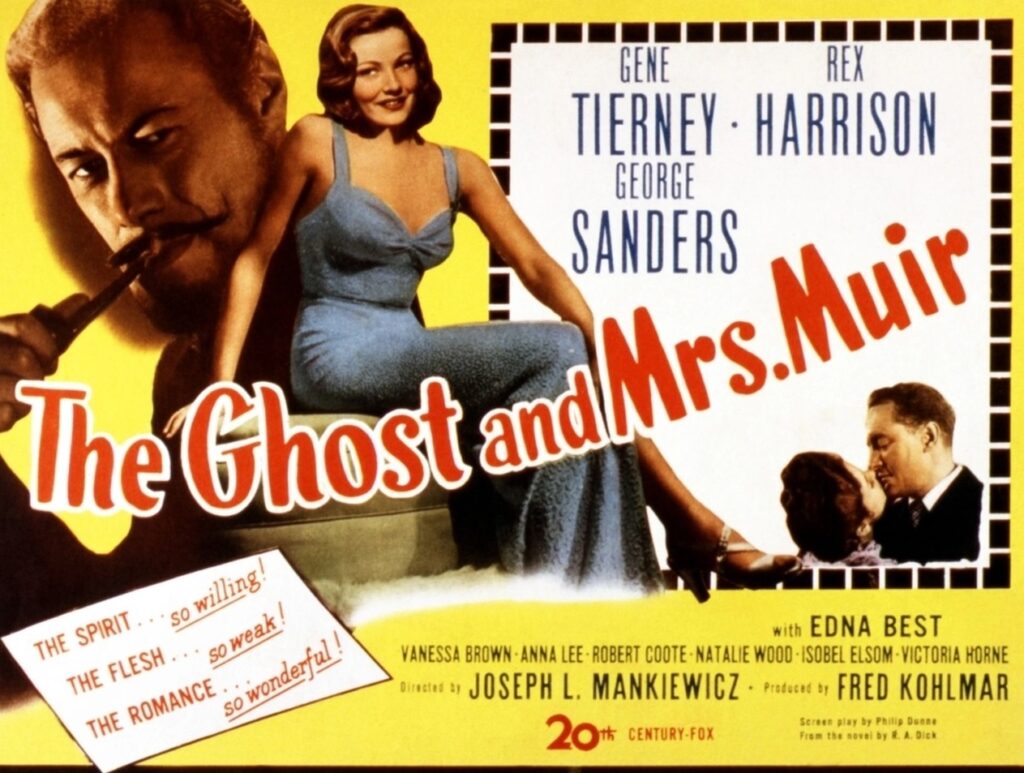
[xiii] Gene Tierney – sporting a very unliikly dress for the turn of last century! Personally, I don’t share the relatively low opinion of Gene Tierney’s acting capabilities that seems to be abroad, including this from Grafe: “She is not a great actress, her impetus quickly falters, her diction is monotonous . . .” but even those who do, must surely agree that the part of Mrs Muir is as perfect for her as the built-in remoteness/woodenness of Madeline and Judy were for Kim Novak in Vertigo? In The Ghost and Mrs Muir, Tierney gets the perfect mixture of obstinate naivety and haughty, high ideals – as well as an underlying sense of Schopenhauer’s proposition that as the world and life can give no true satisfaction they are not therefore worthy of our attachment to them. To quote another (French?) writer Grafe doesn’t credit: “in some films” Tierney was “simply a genius”.
[xiv] Ibid., https://www.poetryfoundation.org/poems/44885/annabel-lee
[xv] https://horrorfilmhistory.com/wp/roger-cormans-poe-cycle-1960-1964/
[xvi] https://www.imdb.com/title/tt0055304/mediaviewer/rm3959808001/
[xvii] See the final image of Patrick Pritchett’s perceptive apostacy for the recreated dacha floating on the surface of Solaris: http://writingthemessianic.blogspot.com/2011/06/my-solaris-problem-or-then-and-now.html
[xviii] https://www.imdb.com/title/tt0069293/
[xix] https://en.wikipedia.org/wiki/Forced_perspective
[xx] https://en.wikipedia.org/wiki/Sch%C3%BCfftan_process
[xxi] https://www.imdb.com/title/tt0065669/
[xxii] An email from my son Joe, Jan 29th, 2022: “I am strongly inclined to agree that the greatest artworks never ‘complete themselves’. Not just in the sense that there’s always room for reinterpretation, but also perhaps because through them you seem to glimpse a world in which you could dwell (or in which you have dwelt?) Maybe this is also connected to the way in which you as a viewer/reader are involved. I suppose in the most strictly ‘Classical’ (‘Apollonian’) works you are a detached spectator to whom a perfect whole is exhibited, which contributes to the sense of completeness. But on the other hand, if you are too deeply caught up in ‘the action’ – the intention of many novelists and filmmakers – then there’s nothing left at the end, you’re just back in the ‘real world’ and it’s done-with. So, I think the best stuff somehow places the reader/viewer(/listener?) somewhere in between, as if you’re a background character perhaps. Obviously this all applies mostly to novels and films, loosely narrative art, I wonder if there’s an equivalent analysis for painting and music …”
Part of a reply, Jan 30th, 2022: “Celeste & I rewatched The Ghost & Mrs Muir yesterday and for a Hollywood product it’s surprisingly (inadvertently?) resistant to completing itself – I always feel I could watch it again next week even though the first 40 minutes of the running time is so relaxed that via the two extreme time jumps (10 or 12 years spanned in 50 seconds, then later, about 20 years in 37 seconds – both to Herrmann’s music of course) the conclusion feels distinctly rushed. But perhaps these very imperfections (into which you can subconsciously pour all your own thoughts/alternative lives/sympathies/questions etc) are exactly what make it both perfect and inexhaustible?”
[xxiii] https://en.wikipedia.org/wiki/Cthulhu_Mythos
[xxiv] https://en.wikipedia.org/wiki/The_Shadow_over_Innsmouth
[xxv] Though I recently acquired a copy of Glasby’s book and am trying to find the Lovecraft which may be in an anthology in one of our boxes still unsorted after moving to Morecambe.
[xxvi] See the forthcoming (part 4) ‘Image supplement’ for photographs of the wider kingdom
[xxvii] https://en.wikipedia.org/wiki/Poulton-le-Sands
[xxviii] https://en.wikipedia.org/wiki/Moonfleet_(novel)
[xxix] https://www.imdb.com/title/tt0048387/?ref_=nv_sr_srsg_0
[xxx] https://en.wikipedia.org/wiki/Cosmicism
[xxxi] A synopsis of The Weird Shadow Over Morecambe: “Drink-addled Mandrake Smith, former Professor of Anthropology at Oxford, now barely surviving in Morecambe, would be unrecognisable to erstwhile colleagues. He has many things to forget, although some don’t want to forget him. Plagued by the nightmares of his past, he finds himself dragged into a morass of supernatural activity centred around the deposition of filleted corpses in the ancient rock-cut graves at St. Patrick’s Chapel, Heysham Head. Drafted into helping the enigmatic Mr Thorn, he grudgingly assists in trying to stop the downward spiral into darkness and insanity that awaits Morecambe, and then the entire world…”
[xxxii] WRONG AGAIN: The Weird Shadow Over Morecambe is not only satirical but absurdly comic in places . . . and on page 88 of my Linford Mystery Library, large print edition, Eric turns up in effigy: a five-thousand-year-old Egyptian statue unearthed in a local archaeological dig (at a time when Eric was only a boy), turning out to uncannily represent (or presage) – “ Glasses, funny stance and all” – the future comic. Perhaps Glasby had the DVD cover/poster of Morecambe & Wise’s The Intelligence Men at the back of his mind?: https://www.imdb.com/title/tt0059315/mediaviewer/rm51354624/
[xxxiii] From: Bombed Out (in Morecambe), November 2021
[xxxiv] https://en.wikipedia.org/wiki/The_Prisoner
[xxxv] Untamed: stop pleasing, start living. (Pages 280-281). Vermillion (Penguin, Random House), London, 2020.
[xxxvi] Edna Best’s best-known role could be in Hitchcock’s The Man Who Knew Too Much (1934) as a champion shot, who grabs a rifle from a police marksman to save her daughter . . .
[xxxvii] Martha seems to be both friend and beloved servant – a faux, salt-of-the-earth cockney who like the woman of colour, the ‘mammy’ so common to films of an earlier and overlapping period, were always the most stable, loving and dependable people of all. The token gay, fat, ugly or non-white best friends who took over the steadfast person role in the 1970s and 80s – were they a step forward?!!
[xxxviii] https://en.wikipedia.org/wiki/Midland_Hotel,_Morecambe
[xxxix] https://twsmedia.co.uk/2019/01/11/bring-me-sunshine-lancaster-to-morecambe-heysham/
[xl] https://en.wikipedia.org/wiki/List_of_railway_companies_involved_in_the_1923_grouping#
[xli] : http://www.disused-stations.org.uk/m/morecambe_euston_road/#
[xlii] https://en.wikipedia.org/wiki/Wakes_week
[xliii] I first visited the town without much attention back in 1981, to look at a student let, though I was never an official student myself. Over the years I found the promenade on a couple of other occasions but never explored south of The Battery – the building which, until 1928, marked the boundary between Morecambe and Heysham.
[xliv] https://www.rvpt.co.uk/
[xlv] https://exploremorecambebay.org.uk/whats-on/morecambe-vintage-bus-day-2022/
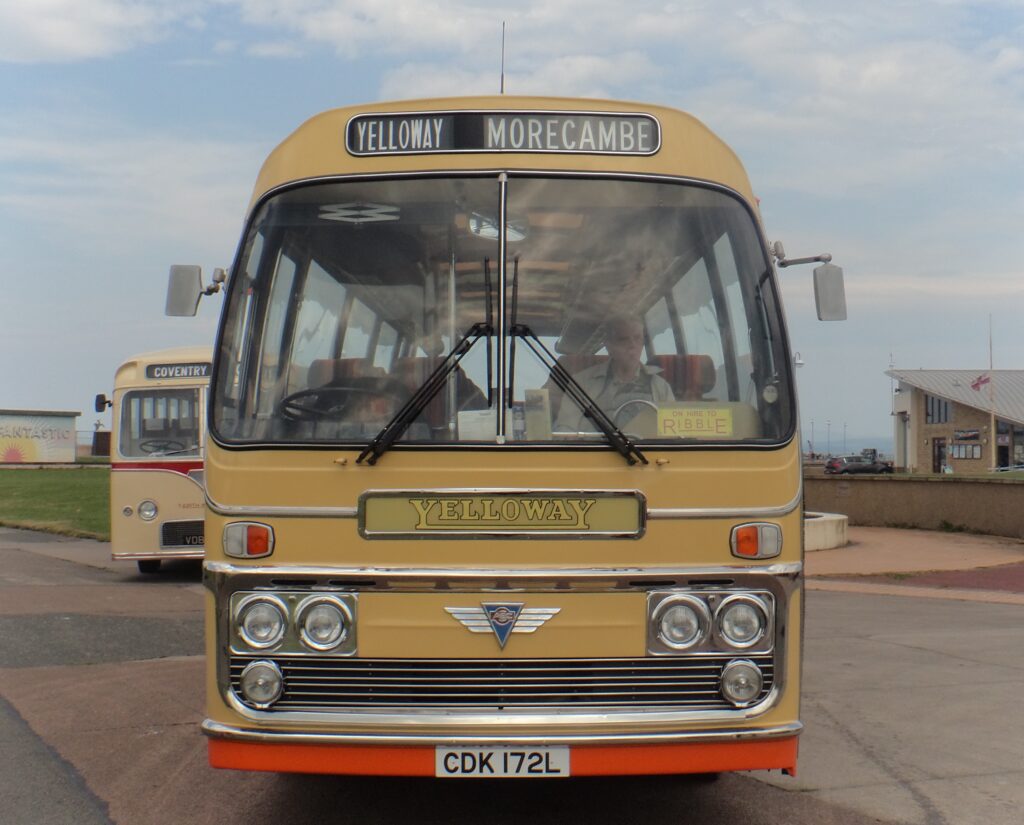
Marine Road Central, Morecambe, May 2018 – A Plaxton Panorama Elite from 1973
[xlvi] https://www.lancastervision.com/weekend-walk-sunderland-point/
[xlvii] https://en.wikipedia.org/wiki/Listed_buildings_in_Overton,_Lancashire#/media/File:Old_Hall,_Sunderland_Point.jpg
[xlviii] https://en.wikipedia.org/wiki/West_End_Pier,_Morecambe
[xlix] https://www.imdb.com/title/tt0055230/
[l] https://en.wikipedia.org/wiki/Morecambe_Bay_cockling_disaster
[li] Herrmann’s music is universal also in the way it often evokes and links emotive passages of other films he has scored, such as Vertigo and Fahrenheit 451 . . . allusions to hover at the back of the mind.
[lii] https://en.wikipedia.org/wiki/Tears_in_rain_monologue
[liii] There are countless images better than mine: https://www.photonorth.co.uk/-/galleries/lancashire-coast/heysham-photos
[liv] Ibid., Bombed Out Nov 2021
[lv] https://en.wikipedia.org/wiki/Rollright_Stones
[lvi] Ibid., Bombed Out Nov 2021
Lawrence Freisleben

Exquisite writing and so much food for thought. The Ghost and Mrs Muir is a wonderful film and your analysis of it and its connections with Morecambe are wonderful to read. Thank you.
Comment by Alison B Fisher on 21 November, 2022 at 7:45 am